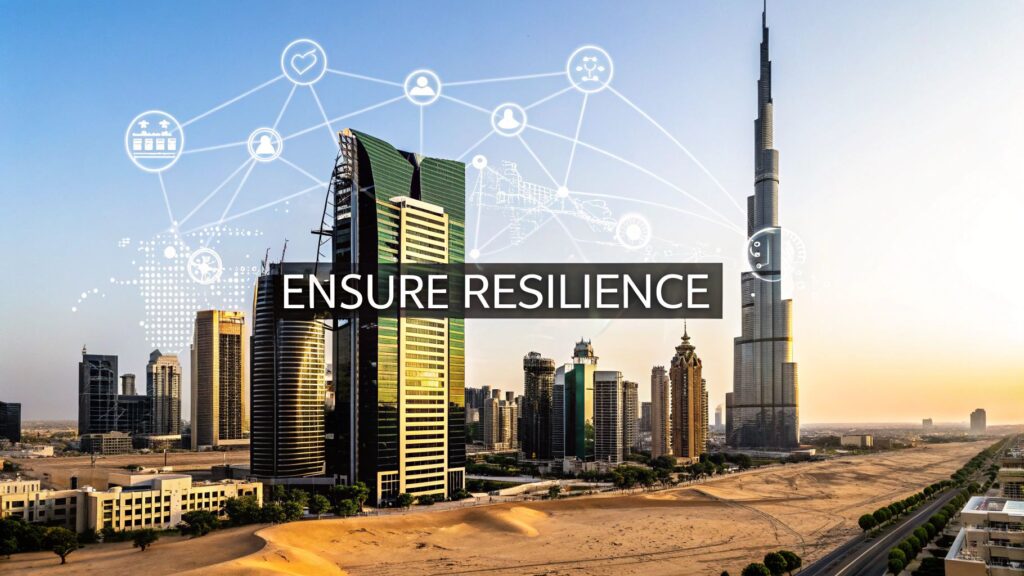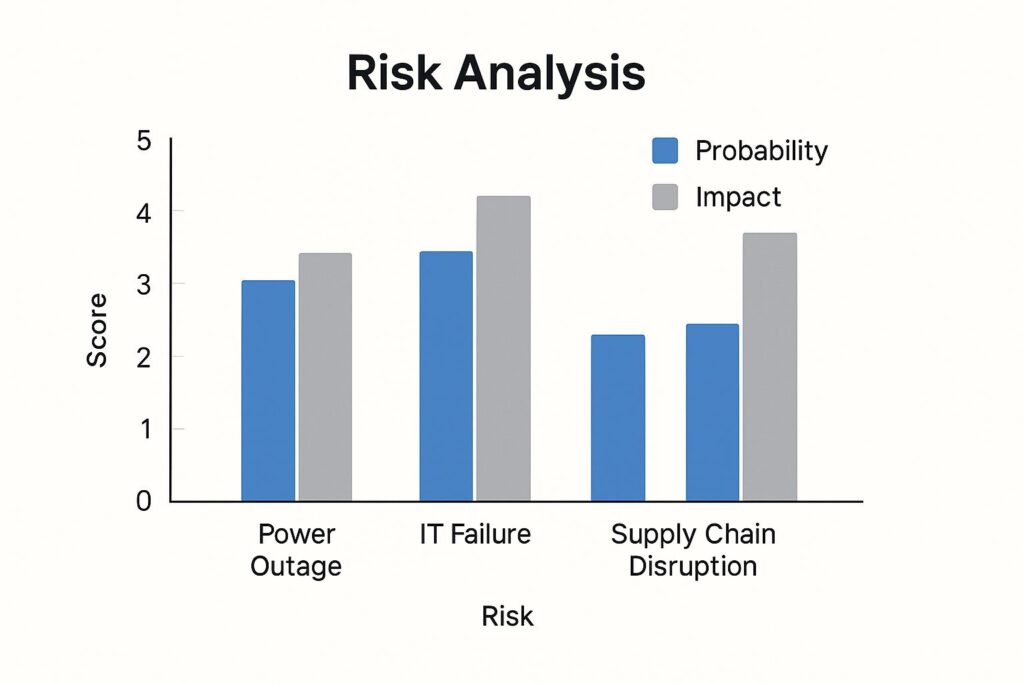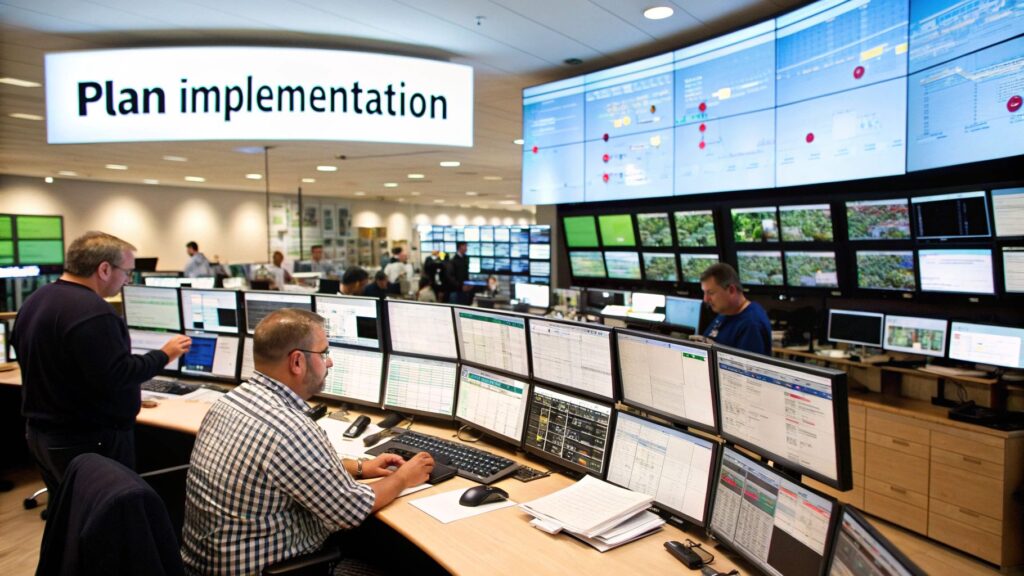
The Middle East Approach to Business Continuity Planning

Traditional Western business continuity models often prove inadequate in the Middle East. The region’s unique combination of rapid economic expansion, ambitious digital transformation initiatives, and specific environmental considerations require a more nuanced approach to business continuity planning. The rapid growth of sectors like technology and tourism, for example, introduces new dependencies and vulnerabilities. Organizations must therefore continually adapt their continuity strategies to these evolving risks.
A Business Continuity Planning in Dubai refers to a comprehensive strategy developed by companies operating in the emirate to ensure critical business operations continue during and after disruptions. These disruptions could include natural disasters, cyberattacks, utility outages, pandemics, or regulatory issues.
Addressing Regional Challenges
A key aspect of business continuity planning in the Middle East is finding the right balance between the best international practices and local cultural norms. Decision-making processes during a crisis are often influenced by cultural nuances and established hierarchies. It’s essential to incorporate these factors into planning and communication protocols. Furthermore, regional organizations must consider unique infrastructure limitations. This could include limited access to reliable backup power or data centers in certain areas.
The Middle East’s focus on digital transformation also presents new operational dependencies and cybersecurity risks. For instance, relying on cloud-based services, while offering many benefits, can expose organizations to disruptions if connectivity is compromised. This highlights the importance of diversifying IT infrastructure and implementing robust cybersecurity measures. In the United Arab Emirates and the broader Middle East, business continuity planning (BCP) has become increasingly important amidst rapid economic and digital development. Specifically, Saudi Arabia’s Vision 2030 initiative has spurred the adoption of BCP strategies to manage risks associated with economic diversification and technological advancement.
Practical Steps for Effective BCP
Creating a robust business continuity plan involves several key steps:
- Business Impact Analysis (BIA): This involves identifying critical business functions and the potential consequences of disruptions.
- Risk Assessment: This step focuses on evaluating specific threats and vulnerabilities relevant to the region.
- Recovery Strategies: This includes developing detailed procedures for restoring critical functions, taking into account any local infrastructure constraints.
- Communication Plan: A clear communication plan establishes channels for disseminating information within the organization and with external stakeholders.
- Testing and Training: Regularly testing the plan and providing employees with training on their respective roles and responsibilities is vital for preparedness.
Integrating Regional Expertise
Organizations looking ahead are actively engaging regional experts and consultants to glean valuable local insights. This includes incorporating specific knowledge of regional regulatory requirements and cultural sensitivities. By adapting their strategies accordingly, organizations can more effectively address region-specific risks while upholding global compliance standards. This proactive approach is crucial for ensuring the effectiveness and relevance of business continuity plans within the dynamic Middle East environment. It empowers organizations to build resilience and maintain operational stability when facing a wide range of challenges. Ultimately, a well-structured and regionally adapted business continuity plan provides a significant competitive edge in the Middle East market.
Beyond the Obvious: Critical Risks You’re Overlooking
While global disruptions grab headlines, organizations in the Middle East face unique challenges requiring specific attention within their business continuity planning. This means thoroughly examining the distinct risk landscape of the region, including infrastructure vulnerabilities and evolving cyber threats targeting key sectors. For example, increasing reliance on digital infrastructure creates new vulnerabilities often overlooked in traditional business continuity plans. This necessitates a more thorough and comprehensive risk assessment process.
Region-Specific Risks in the Middle East
The Middle East’s rapid digital transformation and infrastructure expansion present both exciting opportunities and significant vulnerabilities. The shift towards smart cities and online services, while beneficial, creates dependencies on technology and data integrity.
Additionally, regional geopolitical factors and environmental conditions like extreme heat can disrupt operations. These factors require a proactive approach to business continuity planning that anticipates and addresses potential disruptions.

The infographic above illustrates the probability and potential impact of three common business disruptions: power outages, IT failures, and supply chain disruptions. As shown, IT failures present the highest combined probability and impact, highlighting the critical need for robust IT disaster recovery plans.
However, each risk’s relative importance varies depending on the specific industry and operational context of each business.
Expanding the Risk Horizon
Regional risk assessments for the Middle East, including the UAE and Saudi Arabia, in 2024 emphasize climate change and digital disruption as rapidly escalating risks affecting business continuity. A survey of nearly 100 regional business leaders showed crises related to extreme weather and cyber incidents are top concerns. This has driven increased investment in crisis preparedness and resilience. Regulatory bodies have also responded with specific standards, such as the Digital Government Authority’s BCM standards. You can explore this further in the Middle East Risk in Focus 2025 report.
This increased awareness underscores the need to look beyond traditional concerns. Organizations must proactively consider emerging risks, particularly those linked to supply chain vulnerabilities and data security breaches. This proactive approach to business continuity planning is not just about surviving disruptions; it’s about thriving in the face of challenges.
The following table summarizes some of the critical risks facing organizations in the Middle East:
Critical Risks Facing Middle East Organizations
Comparison of key business disruption risks by impact and likelihood for organizations in the Middle East region
| Risk Category | Impact Level | Likelihood | Sector Most Affected | Mitigation Priority |
| Extreme Weather Events | High | Medium | All Sectors, particularly Infrastructure and Agriculture | High |
| Cyberattacks | High | High | Financial Services, Government, and Critical Infrastructure | High |
| Supply Chain Disruptions | Medium | Medium | Manufacturing, Retail, and Healthcare | Medium |
| Geopolitical Instability | High | Medium | All Sectors, particularly Energy and Tourism | High |
| IT Failures | High | High | All Sectors | High |
| Power Outages | Medium | Medium | All Sectors | Medium |
This table highlights the interconnectedness of these risks and the need for a holistic approach to risk management. Addressing these challenges requires a comprehensive strategy encompassing prevention, mitigation, and response planning. By incorporating these considerations into business continuity planning, organizations can build resilience and ensure long-term success.
Building Your Business Continuity Plan That Actually Works

Creating a truly effective business continuity plan requires moving beyond theoretical frameworks and embracing the specific operational realities of your region, especially in the Middle East. This section offers a practical guide to help you build a business continuity plan that addresses your unique needs. We’ll explore the crucial components, from conducting a Business Impact Analysis (BIA) to establishing comprehensive recovery procedures.
Identifying Critical Functions and Recovery Timeframes
The first vital step is pinpointing your truly critical business functions. This involves understanding which processes are absolutely essential for daily operations and revenue generation. Equally important is establishing realistic recovery timeframes. These timeframes should consider the availability of local resources and infrastructure.
For instance, if your business relies heavily on internet connectivity, your recovery timeframe must account for potential disruptions to regional internet service providers. Consider factors like local regulations and the potential impact on supply chains.
Developing Activation Protocols and Documentation
Once critical functions and recovery timeframes are defined, you need clear activation protocols. These protocols outline who is responsible for activating the plan and under what specific circumstances. This is especially crucial within the hierarchical structures often found in Middle Eastern organizations.
Furthermore, thorough documentation is essential. The plan should be readily accessible during a crisis and kept consistently up-to-date. This documentation must clearly outline roles and responsibilities, aligning with cultural expectations and established leadership structures. Clear communication channels are paramount.
Business Continuity Plan Components
To understand the essential elements of a robust business continuity plan, let’s examine the following table. It breaks down each component, its purpose, implementation timeframe, resource requirements, and crucial regional considerations.
To ensure a comprehensive plan, it’s beneficial to organize your efforts with a structured approach. The following table, “Business Continuity Plan Essential Components,” outlines the key elements required for an effective strategy. It details the purpose of each component, the estimated implementation timeframe, the resources required, and specific regional considerations for the Middle East.
Business Continuity Plan Essential Components
Key elements required for an effective business continuity plan with implementation timeline and complexity assessment
| Component | Purpose | Implementation Timeframe | Resource Requirements | Regional Considerations |
| Business Impact Analysis (BIA) | Identify critical business functions and the potential impact of disruptions | 1-2 Months | Internal team and potentially external consultants | Consider local infrastructure and regulatory environment |
| Risk Assessment | Evaluate potential threats and vulnerabilities | Ongoing | Risk management team and specialized tools | Focus on both global and region-specific risks |
| Recovery Strategies | Develop detailed procedures for restoring critical functions | 2-3 Months | IT team, operational teams, and external vendors | Account for local resource availability and infrastructure limitations |
| Communication Plan | Establish communication channels for internal and external stakeholders | 1 Month | Communication team and designated spokespersons | Adapt communication style to regional cultural norms |
| Training and Testing | Conduct regular drills and training exercises | Ongoing | Training team and relevant personnel | Ensure participation and understanding across all organizational levels |
| Plan Maintenance and Review | Update the plan regularly to reflect changes in the business environment | Ongoing | Business continuity team | Incorporate feedback from tests and real-world incidents |
This table provides a practical framework for developing and implementing your business continuity planning strategy. The key takeaway is the importance of ongoing maintenance and review. This ensures your plan remains relevant and effective in the face of evolving risks and challenges. Implementing a robust and well-tested business continuity plan is crucial for organizations in the Middle East to strengthen their resilience and safeguard their long-term success.
Technology That Transforms Business Continuity Planning
Technology is rapidly changing how Middle Eastern organizations approach business continuity planning. This article explores the solutions addressing regional challenges and regulatory requirements. We’ll examine platforms delivering real value, based on insights from industry experts. We’ll also see how businesses are using cloud-based recovery, automated incident management, and predictive analytics to strengthen their resilience. Finally, we’ll analyze technology adoption across key sectors like financial services, healthcare, and government, discussing implementation challenges and proven solutions based on regional deployments.
Cloud-Based Recovery: Ensuring Accessibility and Scalability
Cloud computing is essential for modern business continuity planning, especially given the distinct challenges organizations face in the Arab Emirates (AE) region. Cloud-based recovery environments offer significant advantages, including accessibility and scalability. Data and applications become accessible from anywhere with an internet connection, and resources can be scaled to meet demand.
This flexibility is crucial during disruptions. If a primary data center fails, operations can seamlessly shift to a cloud-based backup. This minimizes disruption to critical services.
Automated Incident Management: Speeding Up Response and Recovery
Automated incident management systems accelerate response and recovery times. These systems streamline communication and task allocation during a crisis. Predefined workflows can be triggered automatically, ensuring rapid and coordinated action.
This reduces reliance on manual processes, which are susceptible to errors and delays, particularly under pressure. Integration with monitoring tools enables real-time alerts about potential disruptions, allowing for proactive issue resolution.
Predictive Analytics: Anticipating and Mitigating Risks
Predictive analytics provides an additional layer of resilience. Analyzing historical data and identifying patterns allows organizations to anticipate and mitigate potential disruptions more effectively. For example, predictive analytics can pinpoint vulnerabilities in IT infrastructure before they cause outages.
This proactive approach strengthens business continuity planning and reduces the impact of unexpected events. This is especially important in a region prone to various disruptions, both natural and man-made.
The growing demand for these advanced tools is reflected in market growth. The business continuity management planning solution market in the Middle East, particularly in the UAE and Saudi Arabia, is expanding rapidly. In 2024, the market was valued at approximately USD 720.5 million. It’s projected to reach nearly USD 3.31 billion by 2034, highlighting the increasing need for robust business continuity solutions. This growth is driven by the rising severity and frequency of disruptions, emphasizing the critical importance of maintaining continuous operations.
Implementation Challenges and Solutions
While these technologies offer numerous benefits, organizations in the Middle East face implementation challenges. These include integrating new systems with existing infrastructure, ensuring data security and compliance with regional regulations, and managing the associated costs. However, strategic partnerships with experienced technology providers can help overcome these hurdles.
For instance, FSI Technology – Trusted partner in Dubai, offers expertise in Cisco solutions, empowering businesses in the UAE to build robust IT system security in Dubai, vital for effective business continuity. They provide tailored solutions for various sectors, from financial services to healthcare, assisting with every step from product selection to after-sales support. This ensures organizations can maximize the potential of these technologies to achieve optimal uptime and resilience. Choosing the right partner is crucial for successful implementation and management of these complex systems.
Testing Your Plan: Beyond Box-Checking Exercises

A well-crafted business continuity plan is only as effective as its execution during a crisis. Regular testing is crucial. However, many organizations, especially in the Middle East, struggle to go beyond perfunctory exercises. This section explores how leading companies in the region are transforming plan testing from a mere compliance activity into a valuable learning experience that strengthens their overall business continuity planning.
From Tabletop Simulations to Technical Recovery
Leading Middle Eastern organizations are implementing more robust testing methods. Tabletop simulations, for instance, are useful for evaluating decision-making processes and communication flows during a simulated disruption. Participants work through hypothetical scenarios, pinpointing potential weaknesses in the plan.
But testing shouldn’t end there. Comprehensive technical recovery exercises are essential for validating the capabilities of backup systems and recovery procedures. These exercises involve simulating real-world disruptions, such as a complete IT system failure, to ensure critical data and applications can be restored within the specified recovery timeframes.
Designing Realistic Disruption Scenarios
Effective testing requires realistic scenarios that mirror the unique operational context of the region. For example, exercises could simulate disruptions from extreme weather, cyberattacks, or regional geopolitical instability. By tailoring tests to these region-specific threats, organizations gain valuable insights into the plan’s effectiveness and identify areas for improvement.
Furthermore, these tests should be customized for different departments and functions, ensuring every team understands its role during a crisis. This facilitates focused feedback and targeted adjustments to the plan.
Capturing Actionable Insights and Maintaining Executive Engagement
Testing isn’t just about finding flaws; it’s about generating actionable insights that lead to meaningful improvements. This requires a structured framework for gathering participant feedback, documenting lessons learned, and incorporating those lessons back into the plan.
Maintaining executive engagement is also critical, especially in the hierarchical organizational structures often found in the Middle East. Senior management should actively participate in testing and demonstrate their commitment to business continuity planning. This not only ensures Top-level buy-in but also cultivates a culture of resilience across the organization.
Testing business continuity plans is not a one-time activity; it’s an ongoing process of improvement. By adopting comprehensive testing methodologies, regional organizations can enhance their resilience, safeguard their operations, and maintain a competitive edge in today’s complex environment. The ultimate goal is not just to survive a disruption, but to emerge stronger and better prepared for future challenges.
Navigating Middle East Regulations Without Losing Your Mind
Business continuity planning in the Middle East presents a unique set of challenges. The regulatory environment is complex and constantly evolving. This section offers a guide to the mandatory rules and optional best-practice frameworks shaping regional planning. We’ll explore important standards like the UAE’s NCEMA requirements and Saudi Arabia’s Central Bank BCM frameworks. We’ll also examine sector-specific rules for banking, healthcare, and telecommunications. This practical guidance, derived from compliance experts, will help you demonstrate compliance during regulatory assessments while maintaining operational flexibility.
Key Regulations and Standards
Understanding each country’s specific regulatory landscape is crucial for effective business continuity planning in the Middle East. In the UAE, the National Emergency Crisis and Disaster Management Authority (NCEMA) sets essential standards. Organizations must adhere to these standards, which outline requirements for risk assessment, plan development, and testing procedures.
Saudi Arabia’s Central Bank has also established Business Continuity Management (BCM) frameworks, particularly for financial institutions. These frameworks provide detailed guidance for maintaining operational resilience and ensuring financial stability during disruptions.
Sector-Specific Requirements
Regulations can vary considerably across different sectors. For instance, the healthcare sector faces strict requirements for patient data protection and the continuous delivery of essential services. The telecommunications industry, considered critical infrastructure, must comply with regulations that ensure network availability and service restoration during emergencies.
The banking sector also faces distinct requirements related to financial data security, transaction processing, and customer service continuity. Addressing these needs requires customized continuity plans reflecting each sector’s specific regulatory burdens and operational realities.
Harmonizing International and Regional Standards
Many organizations in the Middle East aim to align their business continuity planning with international standards such as ISO 22301. This provides a globally recognized framework for business continuity management. However, integrating these international standards with region-specific requirements is vital.
Forward-thinking organizations are developing integrated compliance approaches instead of maintaining separate systems. This streamlines operations and ensures efficient resource allocation. A unified framework can combine the requirements of ISO 22301 with the specific mandates of NCEMA in the UAE or the Saudi Arabian Monetary Authority (SAMA) regulations for financial institutions.
Practical Checklists and Guidance
Practical checklists and implementation guides are available to help organizations of all sizes navigate the complexities of regional regulations. These resources offer step-by-step instructions for building compliant business continuity plans, conducting thorough risk assessments, and implementing effective testing procedures.
They can also provide templates for essential plan components, such as communication protocols and recovery strategies. Using these tools, businesses can simplify the compliance process and focus on building genuine operational resilience. This proactive approach not only ensures regulatory compliance but also creates a stronger, more adaptable organization better equipped to handle future disruptions.
Creating a Culture Where Resilience Actually Matters
Building a culture of resilience isn’t just about having a business continuity plan document. It’s about weaving resilience into the very fabric of your organization, making it an instinctive reaction to challenges. This section explores how leading Middle Eastern organizations are transforming business continuity from a mere compliance exercise into a true source of competitive advantage.
Securing Executive Sponsorship
Gaining genuine support from leadership is paramount. In the Middle East, this often means presenting business cases that align with regional priorities. These might include maintaining market share during times of instability or safeguarding brand reputation within the local community. Framing resilience within the context of cultural values, such as prioritizing long-term stability and community well-being, can further bolster the case for executive sponsorship.
Training That Respects Hierarchy and Culture
Effective training requires sensitivity to hierarchical structures and cultural nuances. While empowering all team members is essential, training programs should acknowledge existing organizational dynamics and communication styles. This might involve customized sessions for different management levels or utilizing culturally appropriate communication methods. The aim is to ensure everyone understands their role during a disruption, fostering a shared sense of responsibility. For example, some organizations have successfully implemented training programs by incorporating scenarios reflecting regional challenges, like supply chain disruptions caused by geopolitical events.
Communication and Decision-Making in a Crisis
Resilience is intrinsically linked to effective communication and decision-making. Middle Eastern organizations often operate within hierarchical frameworks, which can influence how information flows during a crisis. Business continuity plans should clearly outline communication channels and decision-making authority, while being mindful of cultural norms. This can help ensure a swift, coordinated response to disruptions, minimizing confusion and delays. This could involve establishing clear escalation procedures for reporting incidents and assigning specific individuals responsibility for making critical decisions.
Building a strong culture of resilience requires consistent reinforcement. Regular communication from leadership about the importance of business continuity keeps the topic at the forefront. Incentivizing participation in training exercises and acknowledging teams that demonstrate strong preparedness can further embed resilience into the organizational culture.
For over 20 years, FSI Technology – Trusted Cisco partner in Dubai, has provided businesses in the UAE with robust Cisco networking solutions, essential for effective business continuity. Their expertise and comprehensive support can help your organization build the resilient infrastructure needed to withstand disruptions and maintain operations. Visit FSI Technology today to learn how their Cisco solutions can strengthen your business continuity strategy.
